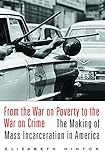From the war on poverty to the war on crime : the making of mass incarceration in America / Elizabeth Hinton
Material type: TextPublication details: Cambridge, Massachusetts ; London, England : Harvard University Press, (c)2016.Description: 1 online resource (449 pages) : illustrationsContent type:
TextPublication details: Cambridge, Massachusetts ; London, England : Harvard University Press, (c)2016.Description: 1 online resource (449 pages) : illustrationsContent type: - text
- computer
- online resource
- 9780674969223
- Criminal justice, Administration of -- Political aspects -- United States -- History -- 20th century
- Urban policy -- United States -- History -- 20th century
- Crime prevention -- United States -- History -- 20th century
- Crime -- Political aspects -- United States -- History -- 20th century
- Imprisonment -- United States
- Crime -- Political aspects -- United States -- History -- 20th century
- HV9950 .F766 2016
- COPYRIGHT NOT covered - Click this link to request copyright permission: https://lib.ciu.edu/copyright-request-form
- digitized 2011 HathiTrust Digital Library committed to preserve
| Item type | Current library | Collection | Call number | URL | Status | Date due | Barcode | |
|---|---|---|---|---|---|---|---|---|
 Online Book (LOGIN USING YOUR MY CIU LOGIN AND PASSWORD)
Online Book (LOGIN USING YOUR MY CIU LOGIN AND PASSWORD)
|
G. Allen Fleece Library ONLINE | Non-fiction | HV9950 (Browse shelf(Opens below)) | Link to resource | Available | ocn945736005 |
Browsing G. Allen Fleece Library shelves, Shelving location: ONLINE, Collection: Non-fiction Close shelf browser (Hides shelf browser)
Includes bibliographies and index.
Introduction : origins of mass incarceration -- The war on black poverty -- Law and order in the Great Society -- The preemptive strike -- The war on black crime -- The battlegrounds of the crime war -- Juvenile injustice -- Urban removal -- Crime control as urban policy -- From the war on crime to the war on drugs -- Epilogue : reckoning with the war on crime
"In the United States today, one in every 31 adults is under some form of penal control, including one in eleven African American men. How did the "land of the free" become the home of the world's largest prison system? Challenging the belief that America's prison problem originated with the Reagan administration's War on Drugs, Elizabeth Hinton traces the rise of mass incarceration to an ironic source: the social welfare programs of Lyndon Johnson's Great Society at the height of the civil rights era. Johnson's War on Poverty policies sought to foster equality and economic opportunity. But these initiatives were also rooted in widely shared assumptions about African Americans' role in urban disorder, which prompted Johnson to call for a simultaneous War on Crime. The 1965 Law Enforcement Assistance Act empowered the national government to take a direct role in militarizing local police. Federal anticrime funding soon incentivized social service providers to ally with police departments, courts, and prisons. Under Richard Nixon and his successors, welfare programs fell by the wayside while investment in policing and punishment expanded. Anticipating future crime, policy makers urged states to build new prisons and introduced law enforcement measures into urban schools and public housing, turning neighborhoods into targets of police surveillance. By the 1980s, crime control and incarceration dominated national responses to poverty and inequality. The initiatives of that decade were less a sharp departure than the full realization of the punitive transformation of urban policy implemented by Republicans and Democrats alike since the 1960s."--Provided by publisher
How did the land of the free become the home of the world's largest prison system? Elizabeth Hinton traces the rise of mass incarceration to an ironic source: not the War on Drugs of the Reagan administration but the War on Crime that began during Johnson's Great Society at the height of the civil rights era
COPYRIGHT NOT covered - Click this link to request copyright permission:
https://lib.ciu.edu/copyright-request-form
Master and use copy. Digital master created according to Benchmark for Faithful Digital Reproductions of Monographs and Serials, Version 1. Digital Library Federation, December 2002. MiAaHDL
http://purl.oclc.org/DLF/benchrepro0212
digitized 2011 HathiTrust Digital Library committed to preserve pda MiAaHDL
There are no comments on this title.







